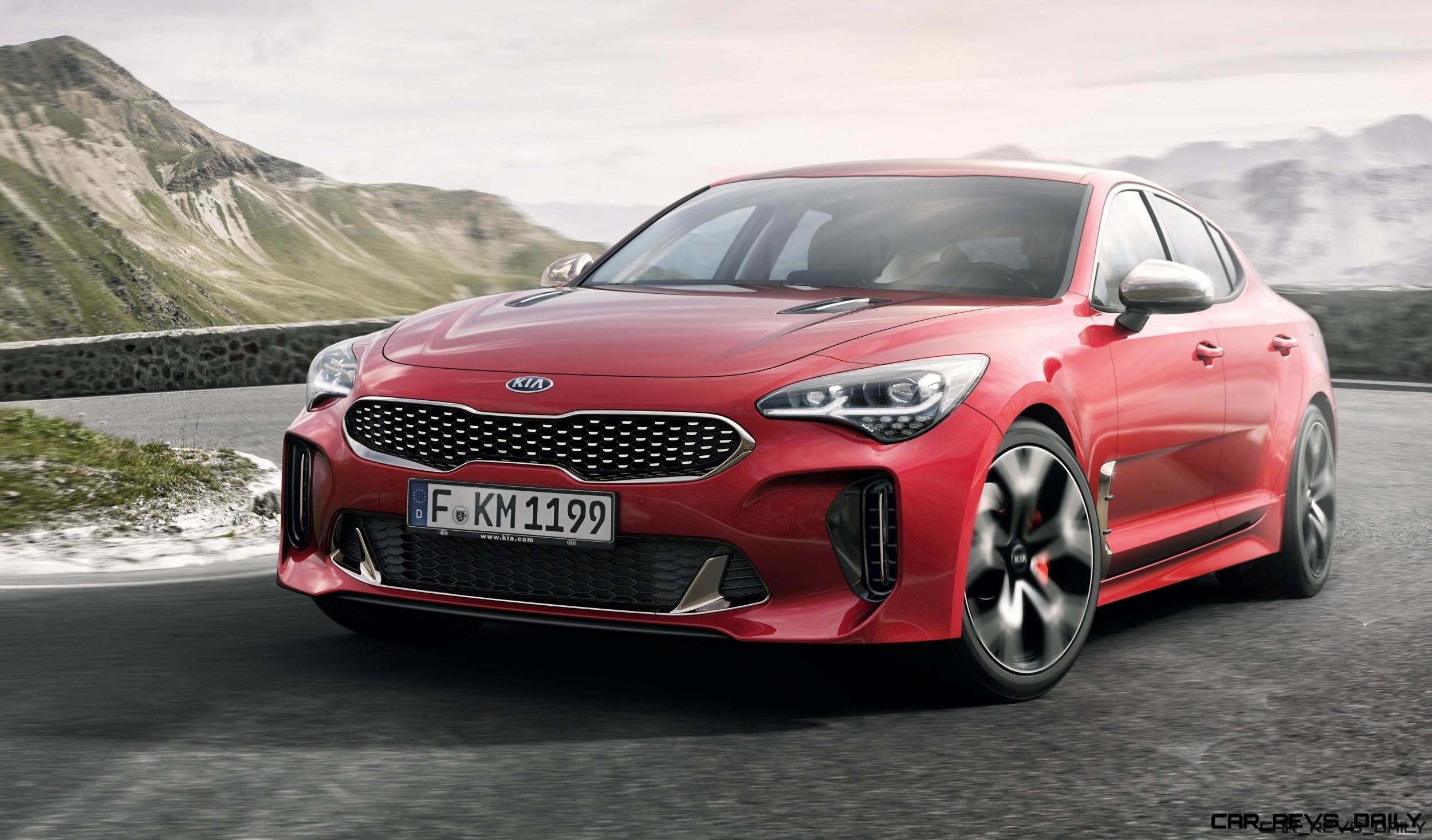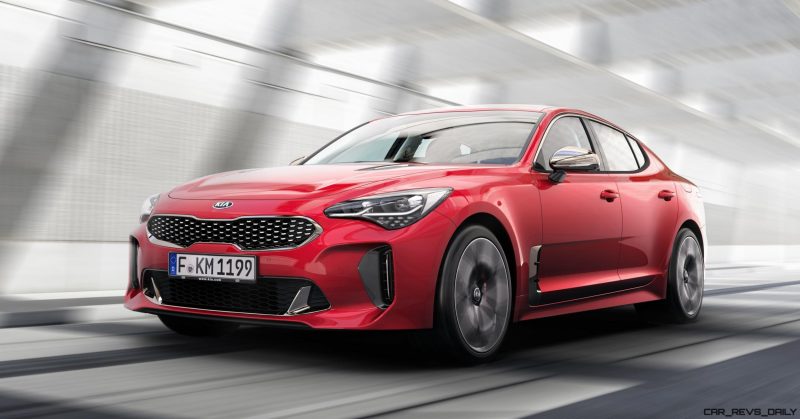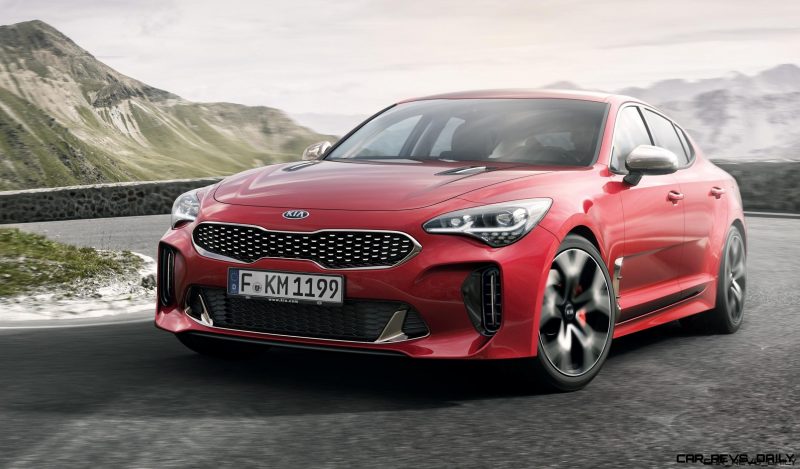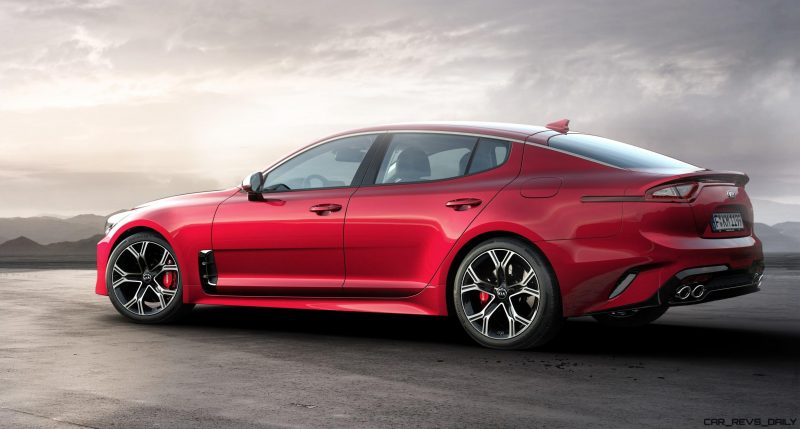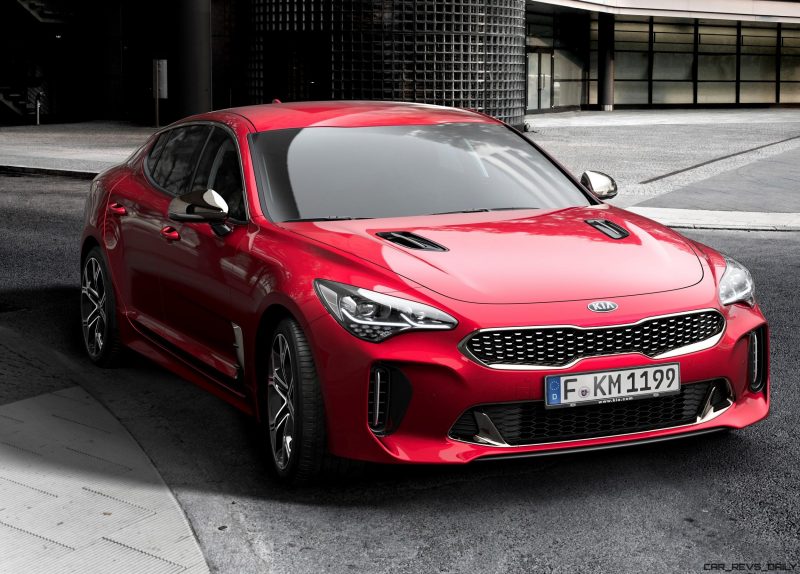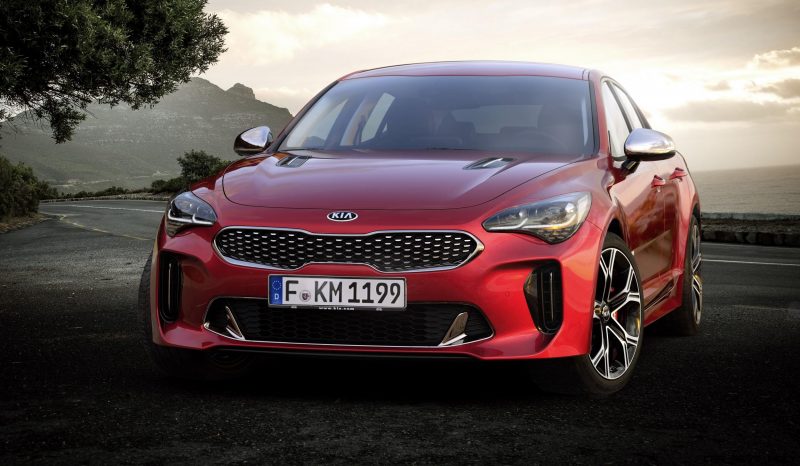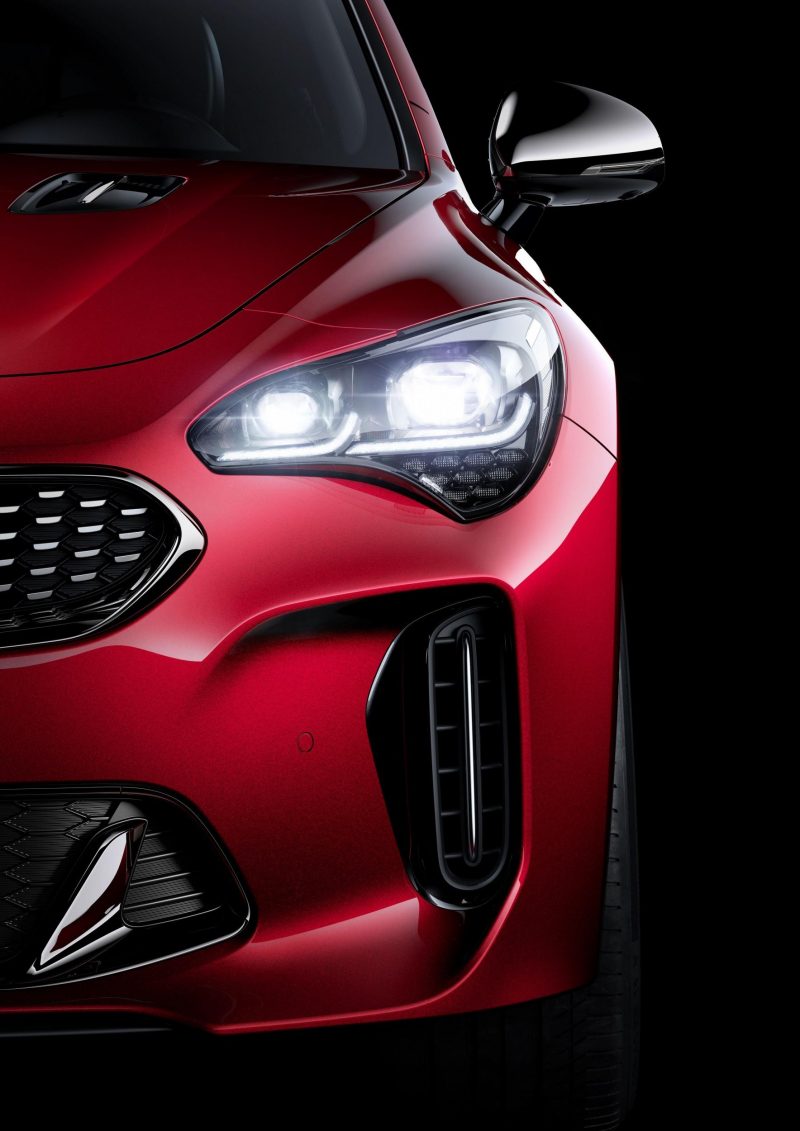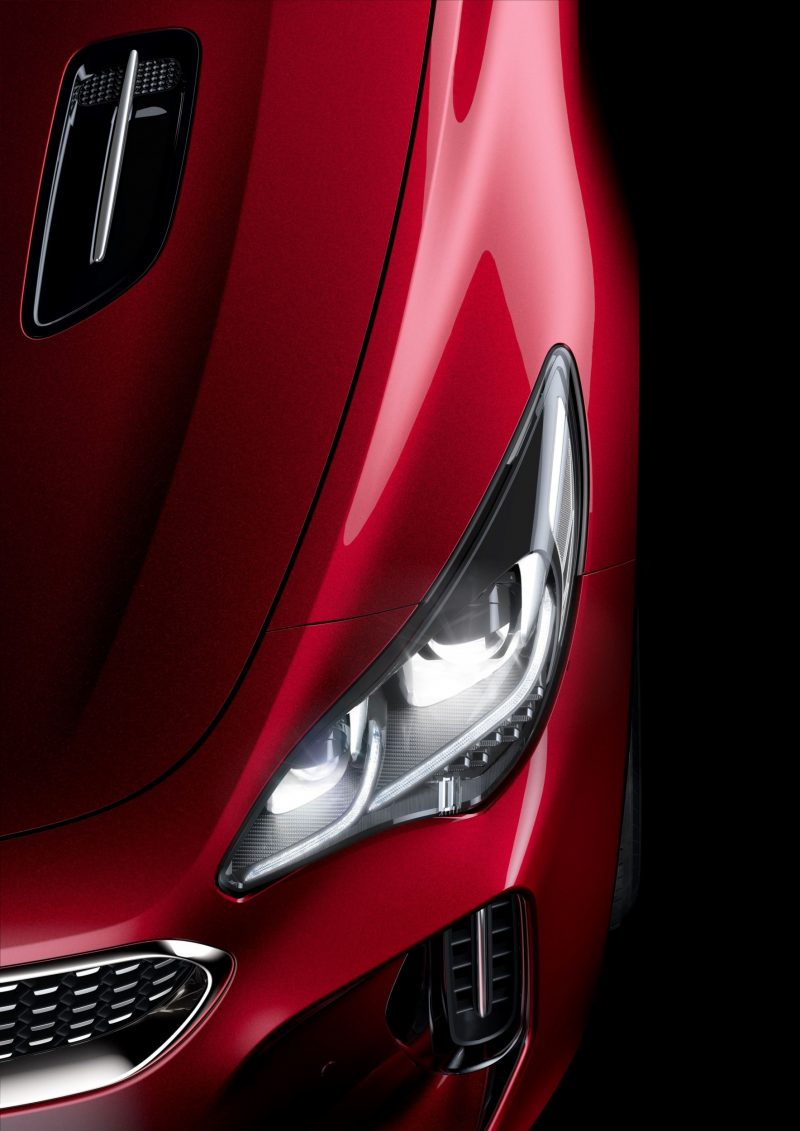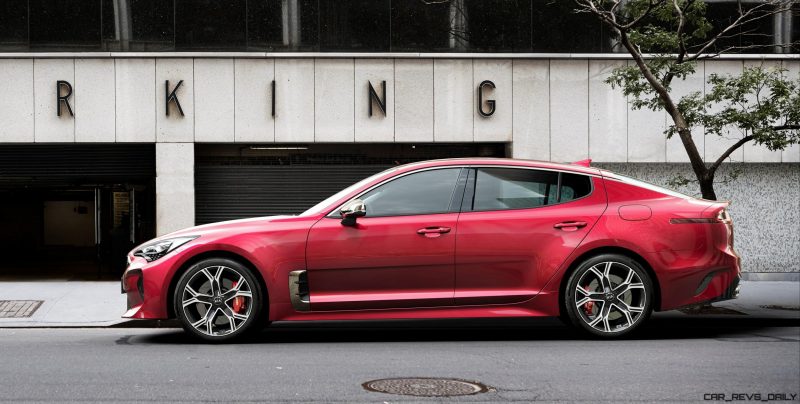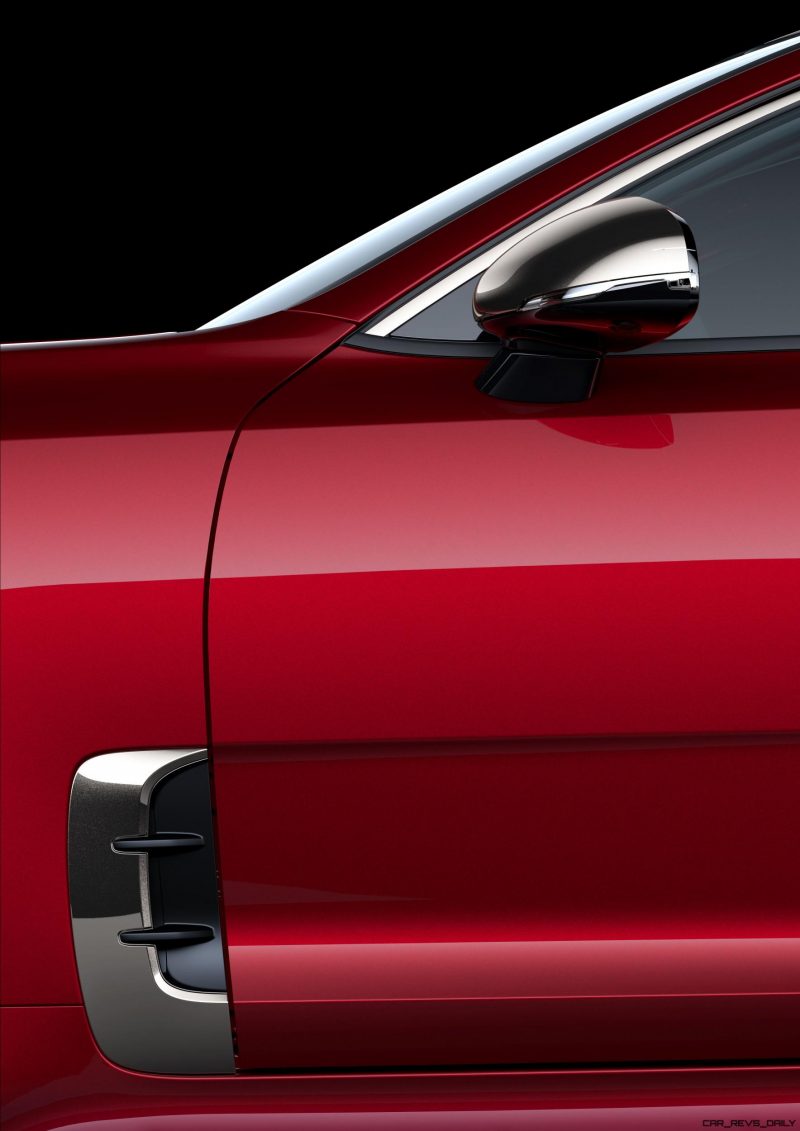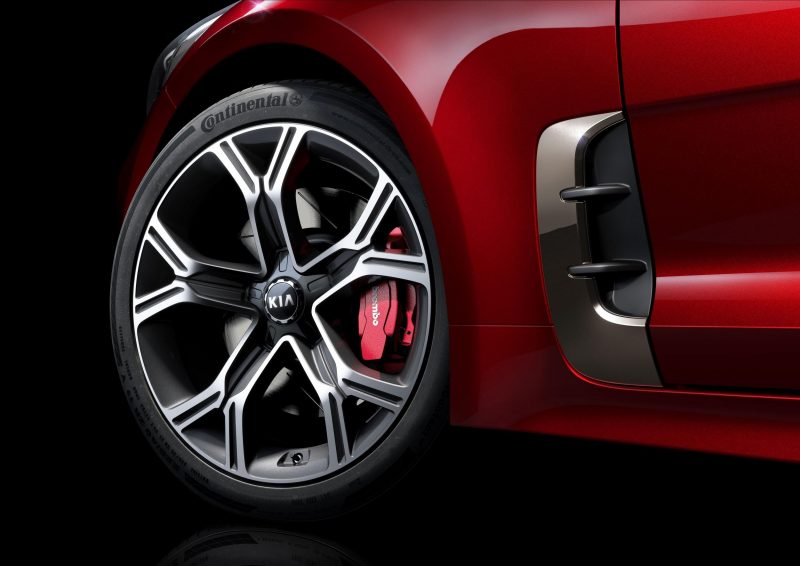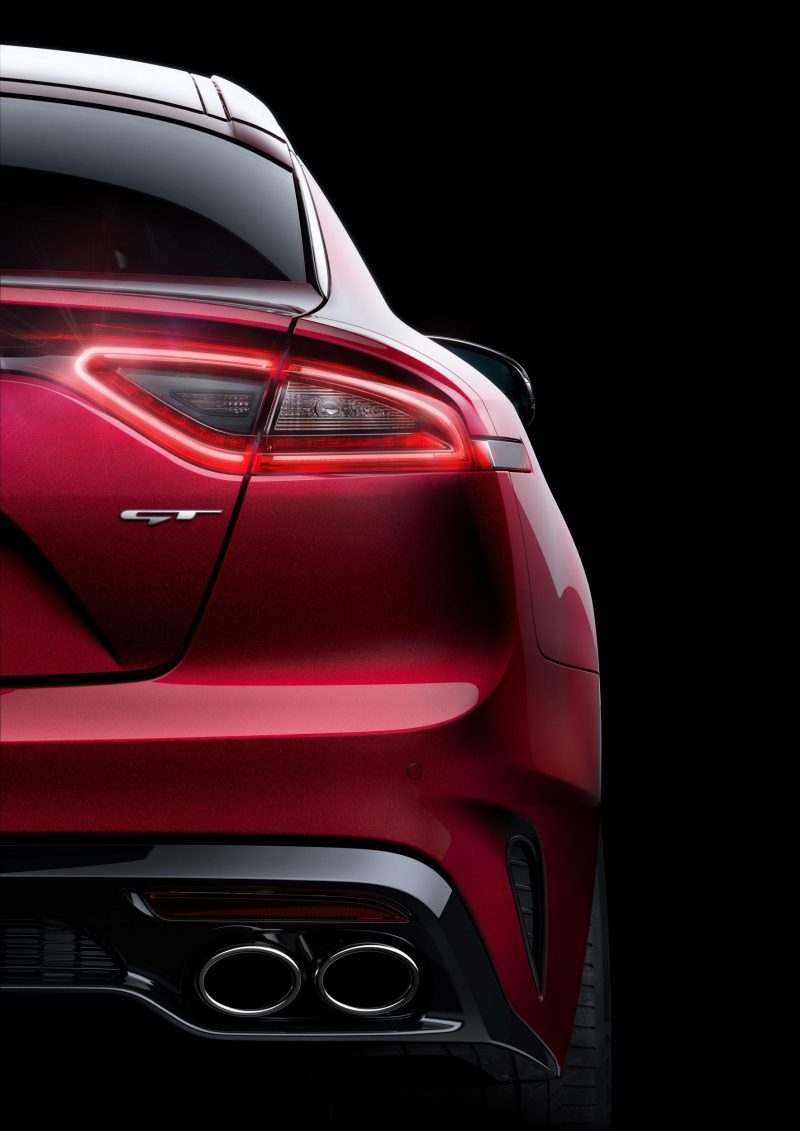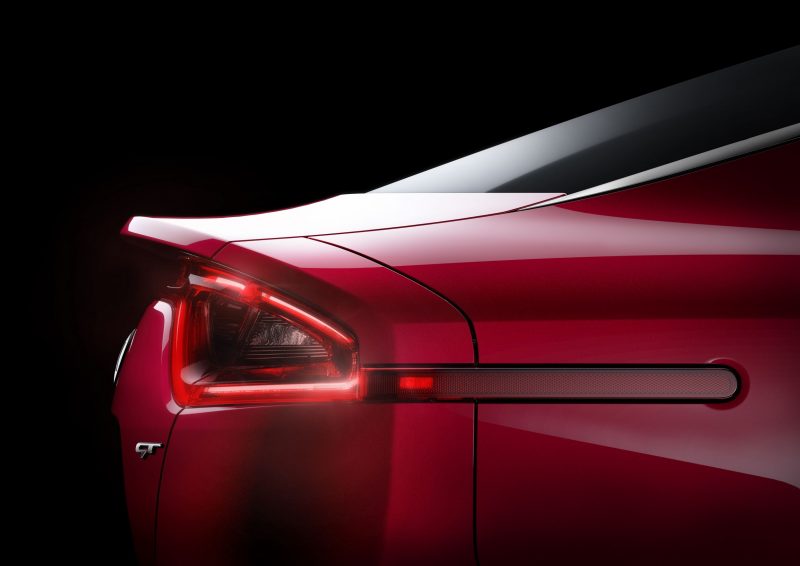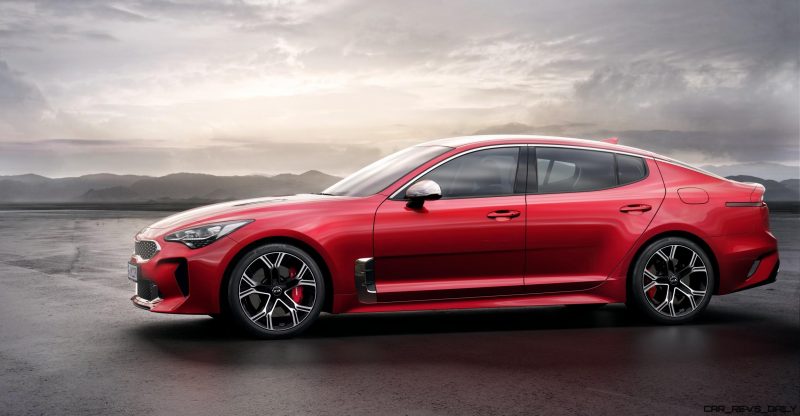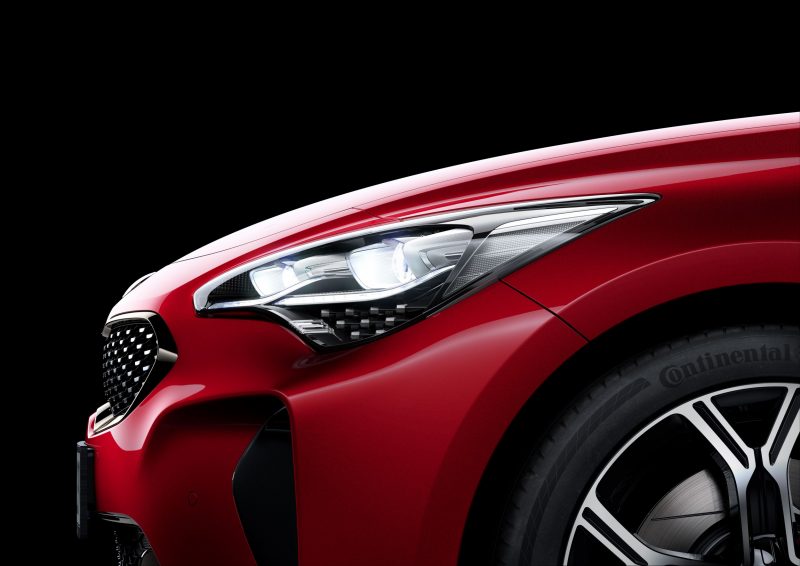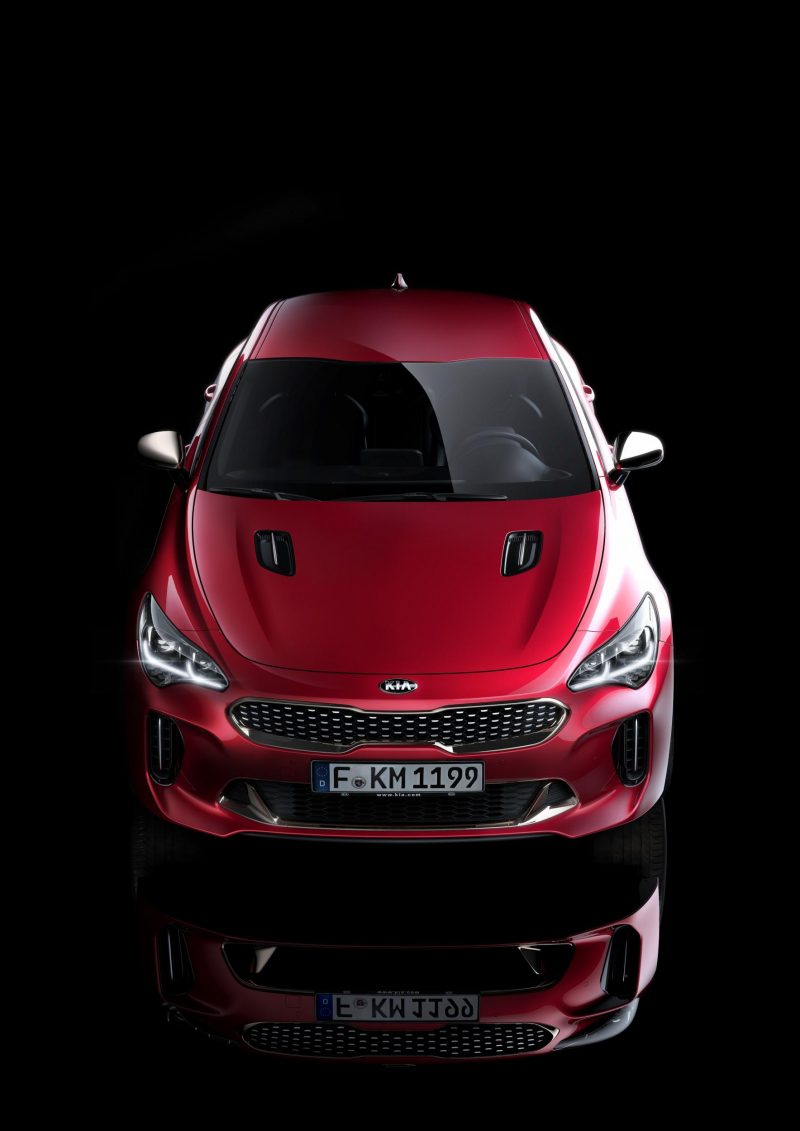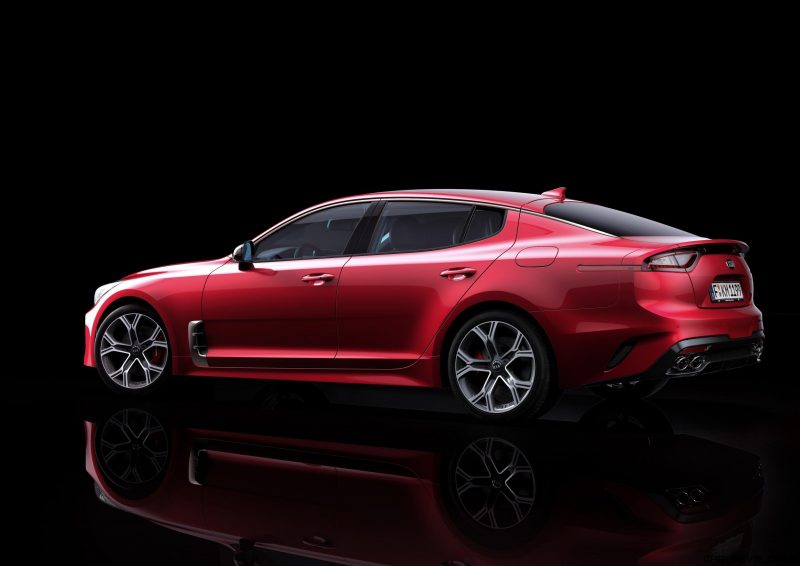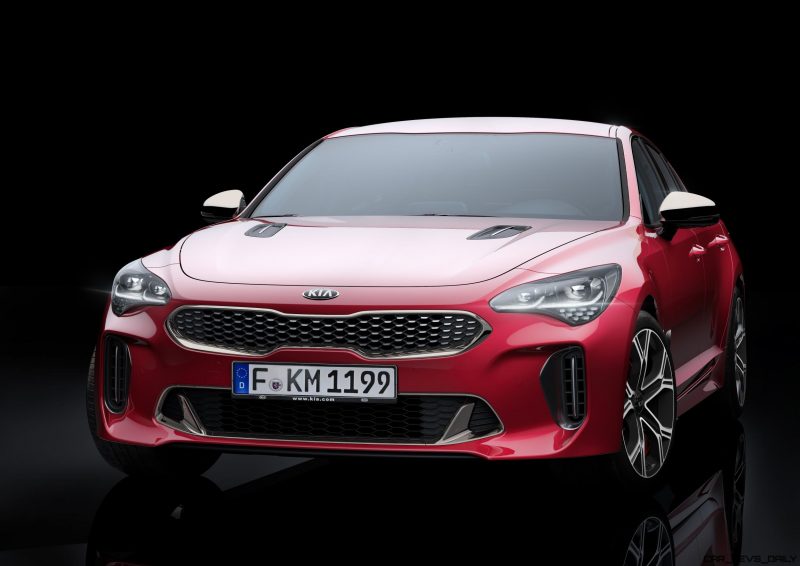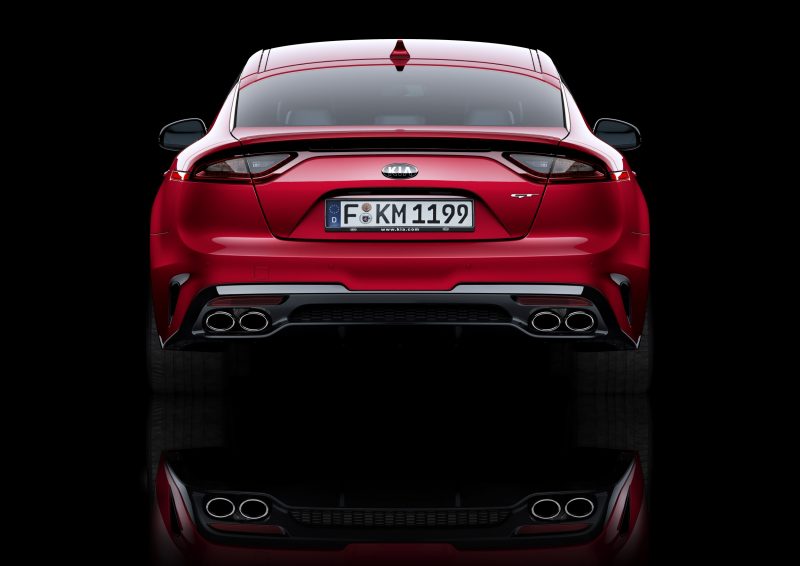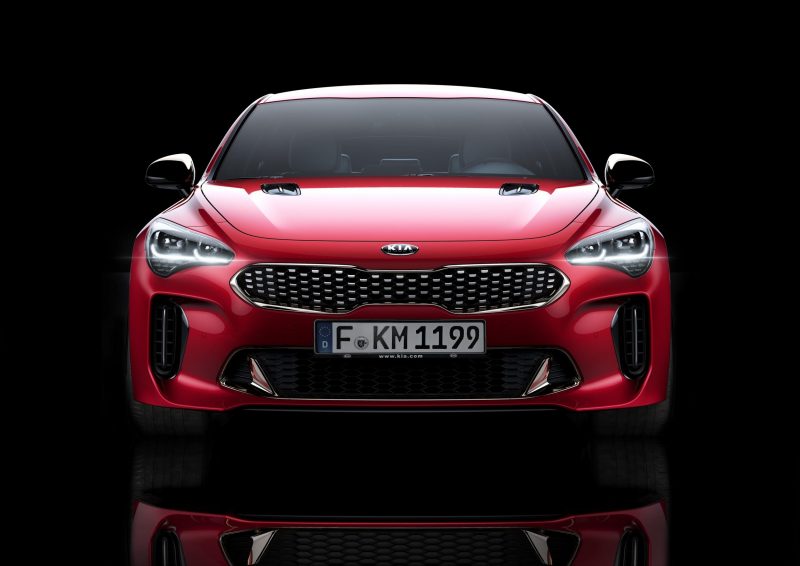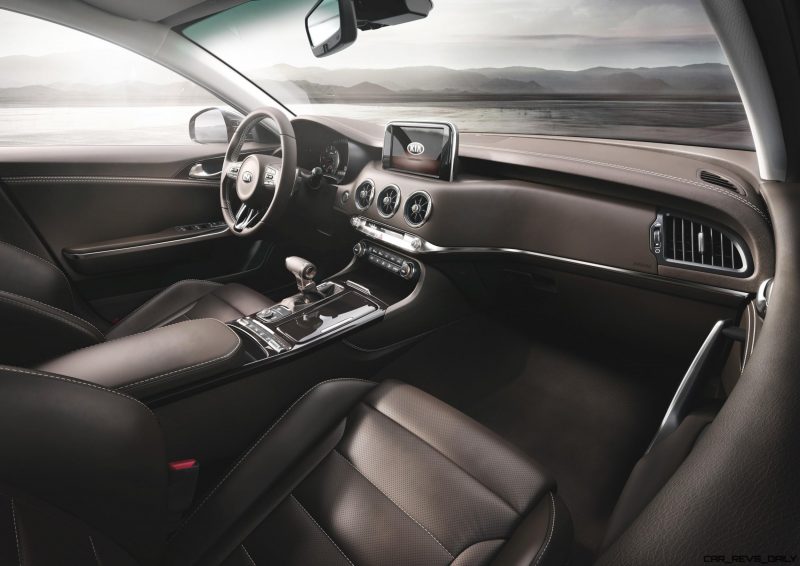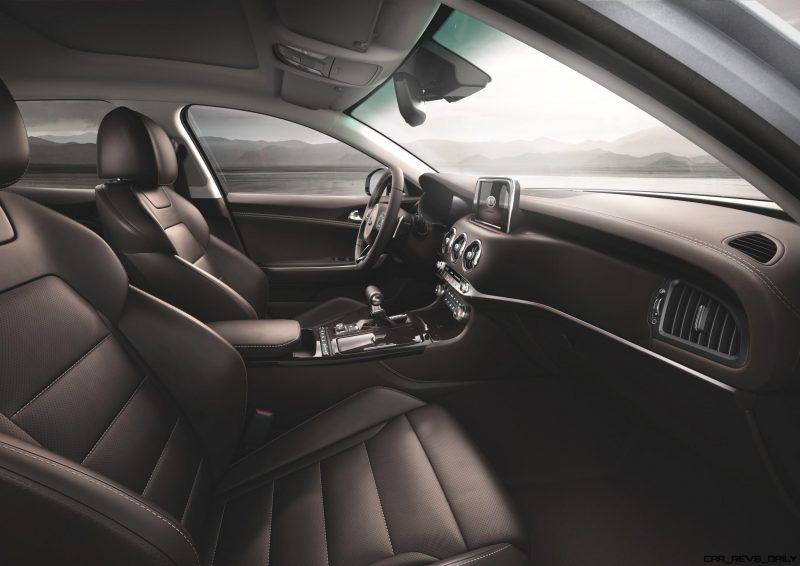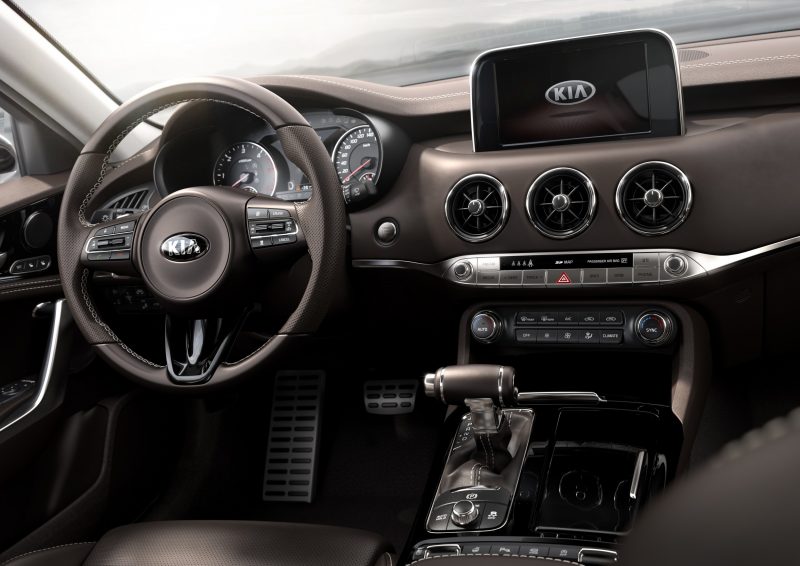All turbo engines, all designed and honed in Germany, and on its way from KIA!?
Get used to a very upgraded Kia in the coming years as it makes a name for itself rivaling BMW. And Audi, and Alfa-Romeo. And Mercedes-AMG?!
At least, that is the goal.
A rear-drive stance and four-door-coupe looks are standard on the new Stinger, even if it is actually front-drive with AWD available.
The cabin is very Benz-like in look and feel, while the exterior blends much of the hyper-rounded but aggressive detailing of the new Alfa Guilia Quadifolio.
The width of the machine and its proportions are the dead giveaways that the Stinger shares little or nothing with the Optima below it or the K900 above.
We salute Kia’s new sporty emphasis in their designs and handling. Look for this car in showrooms around September of 2017 as a 2018 modelyear.
2018 KIA Stinger
2018 KIA STINGER MAKES WORLD DEBUT AT NORTHERN AMERICAN INTERNATIONAL AUTO SHOW
- Kia Motors follows through on the promise of a production model of the GT concept
- Designed in Frankfurt, developed on the Nurburgring, industry-leading quality by Kia
Kia’s dramatic new high-performance gran turismo – the Stinger – has snatched the spotlight at the North American International Auto Show – and event typically dominated by US manufacturers.
A five-seat fastback sports saloon, the Stinger promises to shake up a segment dominated by European products and is the highest-performance production vehicle in the company’s history. Eventually to be offered with multiple engine and drivetrain configurations and luxurious accommodation, the Stinger will arrive in markets around the world later this year. Pricing will be announced closer to the vehicle’s launch date.
“Unlike any Kia that has come before it, the Stinger really is a dream car for us, and here in Detroit, that dream is now a reality after years of commitment and hard work from a passionate group of designers, engineers and executives around the world,” said Orth Hedrick, vice president, product planning, Kia Motors America. “From its GT concept-car origins to the years of tuning and refining on the legendary Nurburgring circuit, no detail was too small to be obsessed over, and the result is simply stunning.”
Instantly recognisable as a direct evolution of the concept that preceded it, the stunning Kia Stinger design was overseen by Peter Schreyer, Kia Motors’ Chief Design Officer, and his talented team of designers in Frankfurt. Ride and handling development was looked after by Albert Biermann, Head of Kia’s Vehicle Test and High Performance Development and his group of engineers in Korea and on the gruelling Nurburgring racing circuit.
But what makes a true gran turismo? This question was the foundation for a journey that began when the GT concept was first unveiled at the 2011 Frankfurt Motor Show. Although every Kia design study has a purpose, the GT concept was something considered by many outside the company as little more than a dream for a brand known for producing mass-market transportation rooted in value. But the GT ignited embers of passion that sparked a fire within the organisation and over the next five years that fire would grow beyond fantasy and morph into reality.
Once the Stinger was given the green-light, that gran turismo question became a mantra as development commenced. Coming from Kia, the design had to be bold. And it was. But it also had to be nimble and fast whilst also luxurious and quiet. It had to achieve the perfect balance of ride and handling and seat five comfortably with room for luggage. It had to be a lot of things, but most of all, it had to be an authentic gran turismo. And it is.
Design
Turning a concept into a production car is no small task and Schreyer looked no further than Kia’s Frankfurt studio – the birthplace of the GT concept – to bring the Stinger to life. “A true gran turismo, a car for spirited long-distance driving, is not about outright power, hard-edged dynamics and brutal styling, all at the expense of luxury, comfort and grace,” notes Gregory Guillaume, Chief Designer, Kia Motors Europe. “The Stinger has nothing to do with being the first to arrive at the destination – this car is all about the journey. It’s about passion.”
From its sleek front through its svelte flanks, and up to its powerful haunches, the Stinger exudes a muscular confidence. Key to its road presence are the rear-wheel-drive proportions; a long bonnet and short front overhang, an extended wheelbase to deliver a spacious cabin, and a long rear overhang with strong shoulders. The Stinger’s stance and visual balance are designed to lend the car an air of elegance and athleticism, rather than boy-racer aggression.
The wide front and rear track, along with the recessed contours along the doors, enhance the visual power of the Stinger’s shoulder line as well as its fastback silhouette. Other purely functional elements of the exterior design – the front air curtains, wheel arch gills, smooth underbody, and integrated rear diffuser – aid its aerodynamic efficiency. The rear valance houses four oval exhaust pipes. Kia’s signature ‘tiger-nose’ grille sits proudly between complex LED headlamps.
The low-slung cabin with its steeply raked windshield and backlight, sits toward the rear of vehicle, creating a fast silhouette. Inside is a space dedicated to the thrill of driving while cossetting the occupants in luxury. Ultra-soft Nappa leather covers the deeply contoured seats and the driver’s seat has available air-cell bladders in the seatback and bolsters for optimal support and comfort.
A confident dashboard creates a strong horizontal plane for the driver to work with. The centre console is intuitively split into two specific areas: the infotainment controls sit neatly below a large colour touchscreen, while the climate and ventilation controls nestle beneath. Ahead of the driver is a thick, leather-wrapped steering wheel and a single instrument binnacle with a combination of analogue and digital instrumentation. The large gauges are ringed in metal and accentuated with sweeping red needles. A colour TFT screen between the gauges relays performance data such as cornering G-forces, lap times and engine-oil temperature, along with ancillary information such as the trip computer, driver settings, navigation and diagnostics.
Aeronautically-inspired spoked circular vents are found front and rear and a tasteful satin chrome trim piece encircles the cabin. The effect is a feeling of cocooned intimacy. But the long wheelbase allows for generous front and rear leg room and the low seating position provides ample head room front and back.
Chassis
Joining the company from BMW in December, 2014, Albert Biermann’s first look at the Stinger signalled to him a car that had to live up to its stunning design from behind the wheel. “I think, for the Kia brand, the Stinger is like a special event,” notes Biermann. “Because nobody expects such a car, not just the way it looks but also the way it drives. It’s a wholly different animal.”
Setting the manufacturing hard-points of the body-in-white would define Stinger and the engineers looked carefully across a landscape dotted with contenders. At 114.4 inches, the Stinger’s wheelbase is longer than the Audi A4, Infiniti Q50, Lexus IS, BMW 4 Gran Coupe and even the Lexus GS and Mercedes CLS. It’s also longer overall (190.2 inches) and wider (73.6 inches) than the others in the segment, allowing for spacious accommodation. The Stinger’s boot area is also larger than many in its class, with enough space for full-size luggage or golf bags and a power tailgate with smart functionality is available.
Riding on a chassis comprised of 55 per cent advanced high-strength steel, the Stinger provides an ultra-stiff foundation for the ride-and-handling engineers to work with. This rigidity also contributes to reduced NVH and a quiet cabin.
The MacPherson front and multi-link rear suspension has been tuned to provide optimal feedback to the driver. A Kia first, ride-damping and vehicle handling traits may be modified by the driver through an electronically adjustable suspension known as Dynamic Stability Damping Control. Whilst always reacting predictably to the driver’s inputs, depending on road conditions and driving style, the Stinger can be tuned to respond with more agility through corners as the system softens the front shocks and firms up the rear. Conversely, improved high-speed stability is achieved when the system stiffens the front shocks and softens the rear. The system is accessed through five drive modes (another Kia first): Personal, Eco, Sport, Comfort and Smart.
Standard variable ratio Rack-mounted Motor Driven Power Steering (R-MDPS) offers razor-sharp feedback through direct mounting of the electric motor on the steering rack, enhancing steering response and reducing unwanted vibration from transmitting through the column. Steering boost is also adjustable through the five selectable drive modes.
Powertrain
If the chassis symbolises the bones of a gran turismo, then surely the available powertrains represent its heart. Oriented longitudinally and set rearward beneath the long, sculpted bonnet, a choice of two turbocharged engines are available, initially.
Both engines are still under final development but the standard 2.0-litre turbocharged four-cylinder Theta II engine produces an estimated 255 horsepower at approximately 6,200 rpm. Max torque of 260 lb.-ft. is available from 1,400 – 4,000 rpm. Performance credentials are further enhanced through the alternative 3.3-litre twin-turbo V6 Lambda II engine, which is anticipated to produce 365 horsepower at an estimated 6,000 rpm and offer max torque of 376 lb.-ft. from 1,300 – 4,500 rpm. Kia is targeting 5.1 seconds to 62 mph and a top speed of 167 mph with the twin turbocharged V6.
The Stinger features a second-generation eight-speed rear-drive automatic transmission. First offered in the K900 luxury sedan, the gearbox has been designed in-house and rewards drivers with crisp shifts and maximised fuel efficiency. More typically found in aviation- and racing-engine applications, the transmission features Kia’s first use of a Centrifugal Pendulum Absorber (CPA) torque converter to help reduce torsional vibrations through the drivetrain. Drivers can let the gearbox manage shifts on its own or may selectively run through the gears via paddle shifters mounted aft of the steering wheel. As with the suspension and steering, up to five different shift patterns may be selected through the vehicle’s electronic drive-mode system. Throttle mapping is also adjusted accordingly.
Recognising that passionate drivers may not always reside in optimal climes, the Stinger is Kia’s first saloon car available with rear- or all-wheel drive – depending on market. Rear-wheel biased for optimal control in the wet or dry, the AWD system features a new Dynamic Torque Vectoring Control system which monitors driver inputs and road conditions and automatically applies power and braking force to the appropriate wheels to maintain course in adverse conditions. Rear-drive vehicles get the benefit of a mechanical limited slip differential to help evenly distribute power through the rear wheels.
A choice of alloy wheels and tyres are also offered. The 2.0-litre turbocharged 4-cylinder models ride on 225/45R-18 performance tyres while the 3.3-litre V6 is shod with staggered ultra-high performance rubber; 225/40R-19 in front and 255/35R-19 at the rear. Vented Brembo® disc brakes are standard on the 3.3-litre twin turbo and feature quad-piston front calipers and dual-piston rear calipers.
Advanced Technology & Convenience
Offering luxurious amenities and unexpected features have become part of Kia’s DNA and the Stinger continues that tradition. Multiple Advanced Driver Assistance Systems (ADAS) seamlessly work together to enhance the driving experience.
In the United States, The National Highway Traffic Safety Administration conservatively estimates that 100,000 police-reported crashes are the direct result of driver fatigue each year. This results in an estimated 1,550 deaths, and 71,000 injuries annually. A Kia first is the new Driver Attention Alert (DAA) system to help combat distracted or drowsy driving. The system monitors a number of inputs from the vehicle and the driver and will sound a warning chime and display a graphic in the instrument binnacle that it’s time to take a break from driving if it senses the driver’s attention level has been significantly reduced.
Forward Collision Assistance (FCA)3 with integrated Autonomous Emergency Braking (AEB) with pedestrian detection can detect a potential collision with another vehicle or pedestrian and help bring the car to a halt. Advanced Smart Cruise Control (ASCC) maintains a pre-set distance between the Stinger and the vehicle in front and can bring the car to a full stop in congested traffic. Lane Keep Assist (LKA) actively monitors the vehicle’s intended lane and will alert the driver with an audible warning along with providing steering input to help maintain the vehicle’s position. Rear Cross Traffic Alert (RCTA) scans the area behind the vehicle when backing from a parking space and will alert the driver with an audible warning if cross traffic is detected.
Connectivity, entertainment and vehicle information can be as important as a dynamic driving experience and the Stinger comes to market with the latest infotainment systems. The height-adjustable colour Head-Up Display (HUD) display enables the driver to see key driving information reflected on the windshield glass, including speed, turn-by-turn navigation, audio and cruise control settings and Blind Spot Detection information. Resting within the centre console is a wireless Smartphone charging pad and Bluetooth hands-free operation is standard while many of the vehicle’s subsystems may be accessed through the steering-wheel-mounted controls.
Long-distance travel is a hallmark of the gran turismo ownership experience and there is a trio of high-performance audio systems designed to turn the interior into a dynamic concert hall as the miles blur by. The base audio system for the 2.0-litre turbo features six-speakers and a seven-inch haptic touchscreen with the latest version of UVO, Kia’s award-winning telematics systems. The standard system found in the 3.3-litre twin turbo ups the speaker count to nine and includes an external amplifier. The available premium Harman/Kardon audio system pumps out 720 watts through an external amplifier to provide crystal-clear music. With 15 speakers and Kia’s first under-seat mounted subwoofers tucked beneath the driver and passenger seats, the system features Clari-Fi, a patented music restoration technology that rebuilds audio signals that are lost in the digital compression process. This technology returns a high-fidelity listening experience to any compressed digital source. The system also comes equipped with next-generation QuantumLogic Surround Sound technology, which extracts signals from the original recording and redistributes them into an authentic, multidimensional soundstage for playback that is clear, refined and full of detail.
| 2018 Kia Stinger (US Model Specifications) | ||
| Engine | Stinger | Stinger GT |
| Type/layout | 2.0L Turbo Charged I4 Theta II | 3.3L Twin Turbo V6 Lambda II |
| Horsepower (estimate) | 255 hp @ 6,200 rpm | 365 hp @ 6,000 rpm |
| Torque (estimate) | 260 lb.-ft @ 1,400-4,000 rpm | 376 lb.-ft @ 1,300-4,500 rpm |
| Block | Aluminum | Aluminum |
| Head | Aluminum | Aluminum |
| Valve System | DOHC D-CVVT 16V | DOHC D-CVVT 24V |
| Displacement (cc) | 1,998 cc | 3,342 cc |
| Bore x stroke (mm) | 86 mm X 86 mm | 92.0 mm x 83.8 mm |
| Compression Ratio | 10.0 : 1 | 10.0:1 |
| Fuel System | GDI (Gasoline Direct Injection) | GDI (Gasoline Direct Injection) |
| Required Fuel | Premium Recommended | Premium Recommended |
| Drivetrain | Stinger | Stinger GT |
| Transmission Gear Ratios: 8-speed automatic transmission | – | – |
| First | 3.964 | 3.665 |
| Second | 2.468 | 2.396 |
| Third | 1.610 | 1.610 |
| Fourth | 1.176 | 1.190 |
| Fifth | 1.000 | 1.000 |
| Sixth | 0.832 | 0.826 |
| Seventh | 0.652 | 0.643 |
| Eighth | 0.565 | 0.556 |
| Reverse | 2.273 | 2.273 |
| Final gear ratio | 3.727 | 3.538 |
| Layout/drive | Front Engine/ Rear or All Wheel Drive | Front Engine/ Rear or All Wheel Drive |
| Exterior Dimensions | Stinger | Stinger GT |
| Length (in.) | 190.2 in. | 190.2 in. |
| Width (in.) | 73.6 in. | 73.6 in. |
| Height (in.) | 55.1 in. | 55.1 in. |
| Wheelbase (in.) | 114.4 in. | 114.4 in. |
| Track, front/rear (in.) | ||
| Overhang, front/rear (in.) | 32.7 in. / 43.1 in. | 32.7 in. / 43.1 in. |
| Interior Dimensions | Stinger | Stinger GT |
| Seating capacity | 5 passenger | 5 passenger |
| Head room | – | – |
| Front (in.) | 39.4 in. | 39.4 in. |
| Rear (in.) | 37.0 in. | 37.0 in. |
| Leg room | – | – |
| Front (in.) | 42.6 in. | 42.6 in. |
| Rear (in.) | 36.4 in. | 36.4 in. |
| Shoulder room | – | – |
| Front (in.) | 56.4 in. | 56.4 in. |
| Rear (in.) | 54.8 in. | 54.8 in. |
| Chassis/Suspension | Stinger | Stinger GT |
| Front | MacPherson | MacPherson |
| Rear | Multi Link (5-link) | Multi Link (5-link) |
| Construction | Steel Unibody | Steel Unibody |
| Steering | Stinger | Stinger GT |
| Type / Power source | Rack and Pinion / Electric motor | Rack and Pinion / Electric motor |
| Variable Gear Ratio | Standard | Standard |
| Turns, lock-to-lock | 2.4 (2WD), 2.3 (AWD) | 2.4 (2WD), 2.3 (AWD) |
| Turning circle, curb-to-curb (ft.) | 36.9 (2WD), 37.5 (AWD) | 36.9 (2WD), 37.5 (AWD) |
| Brakes | Stinger | Stinger GT |
| Front | Ventilated Disc | Brembo 4-Piston Caliper Ventilated Disc |
| Rear | Disc | Brembo 2-Piston Caliper Ventilated Disc |
| Size (in.) front/rear | 12.6″ / 12.4″ | 13.8″ / 13.4″ |
| Wheels/Tires | Stinger | Stinger GT |
| Wheel size (in.) | 8.0J×18 | 8.0J×18 (front) / 9.0Jx19 (rear) |
| Tire size | P225/45R18 | P225/40R19 (Front) P255/35R19 (Rear) |
| Spare Tire | Compact Spare | Compact Spare |

Tom Burkart is the founder and managing editor of Car-Revs-Daily.com, an innovative and rapidly-expanding automotive news magazine.
He holds a Journalism JBA degree from the University of Wisconsin – Madison. Tom currently resides in Charleston, South Carolina with his two amazing dogs, Drake and Tank.
Mr. Burkart is available for all questions and concerns by email Tom(at)car-revs-daily.com.

